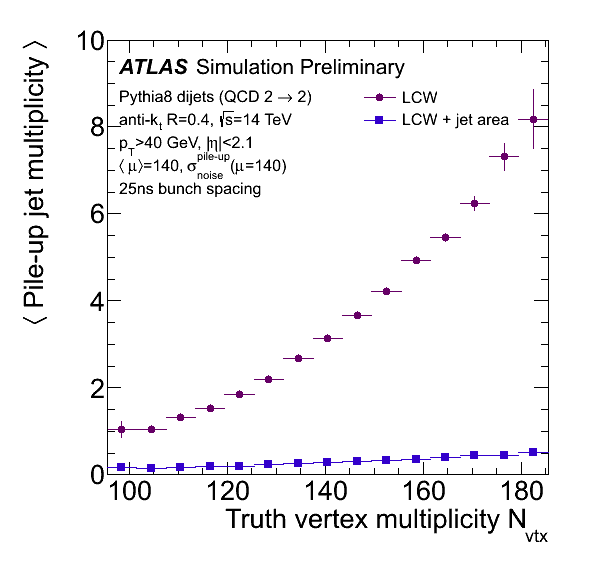
JetEtmissApproved2013HighMuJets
Information Common To All Plots ρ is calculated using kt R=0.4 jets reconstructed from locally calibrated (LCW) topoclusters within |η|<2. The density calculation is with respect to the Voronoi area of the jets as defined in JHEP 0804 (2008) 005| The mean pileup jet multiplicity as a function of the number of truth vertices Nvtx in events with an average number of interactions per bunch crossing (<μ>) of 140. The closed circles (squares) represent the mean number of pileup jets with pT >20 GeV (solid markers) and 40 GeV (open markers) before (magenta) and after (blue) pileup subtraction using the event-by-event median pT density, ρ. Pileup subtraction significantly reduces the mean number of pileup jets per event. |
 [pdf] | |
| The mean pileup jet multiplicity as a function of the number of truth vertices Nvtx in events with an average number of interactions per bunch crossing (<μ>) of 140. The closed circles (squares) represent the mean number of pileup jets with pT >20 GeV before (magenta) and after (blue) pileup subtraction using the event-by-event median pT density, ρ. Pileup subtraction significantly reduces the mean number of pileup jets per event. |
 [pdf] |
|
| The mean pileup jet multiplicity as a function of the number of truth vertices Nvtx in events with an average number of interactions per bunch crossing (<μ>) of 140. The closed squares (squares) represent the mean number of pileup jets with pT >40 GeV before (magenta) and after (blue) pileup subtraction using the event-by-event median pT density, ρ. Pileup subtraction significantly reduces the mean number of pileup jets per event. |
 [pdf] |
|
Major updates:
-- MichaelBegel - 26-Jul-2013 Responsible: MichaelBegel
Subject: public
Topic revision: r3 - 2013-07-30 - MichaelBegel
or Ideas, requests, problems regarding TWiki? use Discourse or Send feedback
